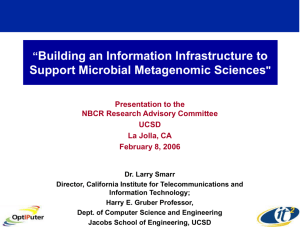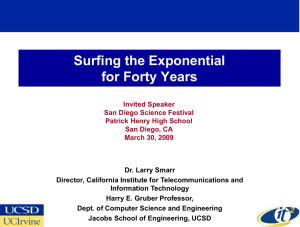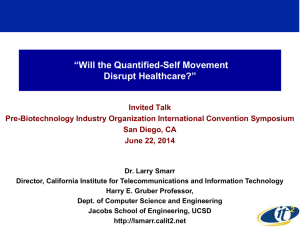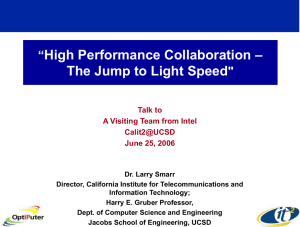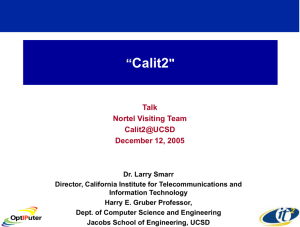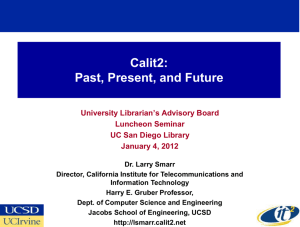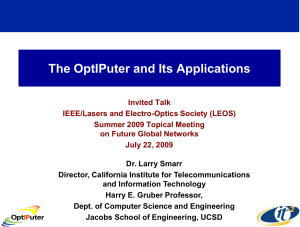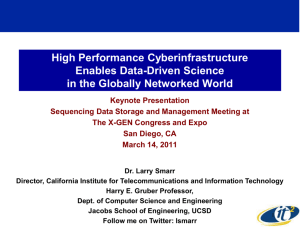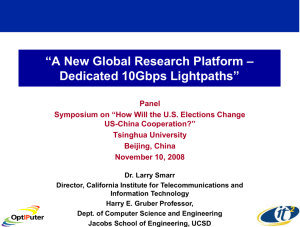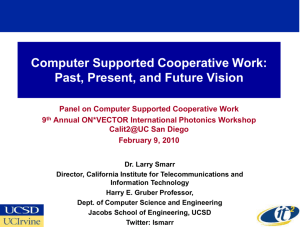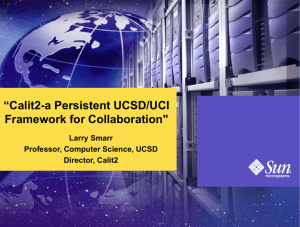The California Institute for Telecommunications and
advertisement
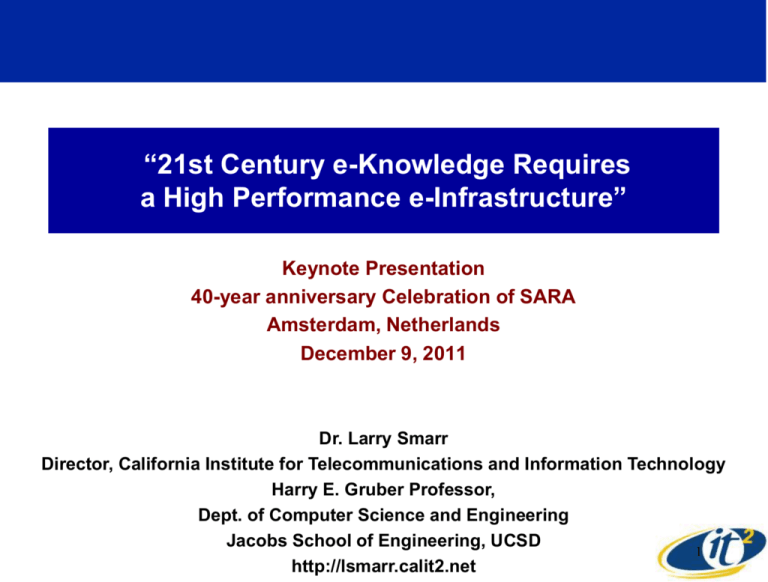
―21st Century e-Knowledge Requires a High Performance e-Infrastructure‖ Keynote Presentation 40-year anniversary Celebration of SARA Amsterdam, Netherlands December 9, 2011 Dr. Larry Smarr Director, California Institute for Telecommunications and Information Technology Harry E. Gruber Professor, Dept. of Computer Science and Engineering Jacobs School of Engineering, UCSD 1 http://lsmarr.calit2.net Abstract Over the next decade, advances in high performance computing will usher in an era of ultra-realistic scientific and engineering simulation-- in fields as varied as climate sciences, ocean observatories, radio astronomy, cosmology, biology, and medicine. Simultaneously, distributed scientific instruments, highresolution video streaming, and the global computational and storage cloud all generate terabytes to petabytes of data. Over the last decade, the U.S. National Science Foundation funded the OptIPuter project to research how usercontrolled 10Gbps dedicated lightpaths (or ―lambdas‖) could provide direct access to global data repositories, scientific instruments, and computational resources from ―OptIPortals,‖ PC clusters which provide scalable visualization, computing, and storage in the user's campus laboratory. All of these components can be integrated into a seamless high performance einfrastructure required to support a next generation e-knowledge data-driven society. In the Netherlands SARA and its partner SURFnet has taken a global leadership role in building out and supporting such a future-oriented einfrastructure, enabling powerful computing, data processing, networking, and visualization e-science services, necessary for the pursuit of solutions to an increasingly difficult set of scientific and societal challenges Leading Edge Applications of Petascale Computers Today Are Critical for Basic Research and Practical Apps Flames Parkinson’s Supernova Fusion Supercomputing the Future of Cellulosic Ethanol Renewable Fuels Atomic-Detail Model of the Lignocellulose of Softwoods. The model was built by Loukas Petridis of the ORNL CMB Molecular Dynamics of Cellulose (Blue) and Lignin (Green) Computing the Lignin Force Field & Combining With the Known Cellulose Force Field Enables Full Simulations of Lignocellulosic Biomass www.scidacreview.org/0905/pdf/biofuel.pdf Supercomputers are Designing Quieter Wind Turbines Simulation of an Infinite-Span ―Flatback" Wind Turbine Airfoil Designed by the Netherlands Delft University of Technology Using NASA's FUN3D CFD Code Modified by Georgia Tech to Include a Hybrid RANS/LES Turbulence model Georgia Institute of Technology Professor Marilyn Smith www.ncsa.illinois.edu/News/Stories/Windturbines/ Increasing the Efficiency of Tractor Trailers Using Supercomputers Oak Ridge Leadership Computing Facility & the Viz Team (Dave Pugmire, Mike Matheson, and Jamison Daniel) BMI Corporation, an engineering services firm has teamed up with ORNL, NASA, and several BMI corporate partners with large trucking fleets Realistic Southern California Earthquake Supercomputer Simulations Magnitude 7.7 Earthquake http://visservices.sdsc.edu/projects/scec/terashake/2.1/ Tornadogenesis From Severe Thunderstorms Simulated by Supercomputer Source: Donna Cox, Robert Patterson, Bob Wilhelmson, NCSA Improving Simulation of the Distribution of Water Vapor in the Climate System ORNL Simulations by Jim Hack; Visualizations by Jamison Daniel http://users.nccs.gov/~d65/CCSM3/TMQ/TMQ_CCSM3.html 21st Century e-Knowledge Cyberinfrastructure: Built on a 10Gbps ―End-to-End‖ Lightpath Cloud HD/4k Live Video HPC End User OptIPortal Local or Remote Instruments 10G Lightpaths Campus Optical Switch Data Repositories & Clusters HD/4k Video Repositories The Global Lambda Integrated Facility-Creating a Planetary-Scale High Bandwidth Collaboratory Research Innovation Labs Linked by 10G Dedicated Lambdas www.glif.is/publications/maps/GLIF_5-11_World_2k.jpg SURFnet – a SuperNetwork Connecting to the Global Lambda Integrated Facility www.glif.is Visualization courtesy of Donna Cox, Bob Patterson, NCSA. The OptIPuter Project: Creating High Resolution Portals Over Dedicated Optical Channels to Global Science Data OptIPortal Scalable Adaptive Graphics Environment (SAGE) Picture Source: Mark Ellisman, David Lee, Jason Leigh Calit2 (UCSD, UCI), SDSC, and UIC Leads—Larry Smarr PI Univ. Partners: NCSA, USC, SDSU, NW, TA&M, UvA, SARA, KISTI, AIST Industry: IBM, Sun, Telcordia, Chiaro, Calient, Glimmerglass, Lucent The Latest OptIPuter Innovation: Quickly Deployable Nearly Seamless OptIPortables 45 minute setup, 15 minute tear-down with two people (possible with one) Shipping Case Image From the Calit2 KAUST Lab The OctIPortable Calit2/KAUST at SIGGRAPH 2011 Photo:Tom DeFanti 3D Stereo Head Tracked OptIPortal: NexCAVE Array of JVC HDTV 3D LCD Screens KAUST NexCAVE = 22.5MPixels www.calit2.net/newsroom/article.php?id=1584 Source: Tom DeFanti, Calit2@UCSD Green Initiative: Can Optical Fiber Replace Airline Travel for Continuing Collaborations ? Source: Maxine Brown, OptIPuter Project Manager EVL’s SAGE OptIPortal VisualCasting Multi-Site OptIPuter Collaboratory CENIC CalREN-XD Workshop Sept. 15, 2008 Total Aggregate VisualCasting Bandwidth for Nov. 18, 2008 EVL-UI Chicago Sustained 10,000-20,000 Mbps! At Supercomputing 2008 Austin, Texas November, 2008 SC08 Bandwidth Challenge Entry Streaming 4k Remote: On site: SARA (Amsterdam) GIST / KISTI (Korea) Osaka Univ. (Japan) U Michigan U of Michigan UIC/EVL U of Queensland Russian Academy of Science Masaryk Univ. (CZ) Requires 10 Gbps Lightpath to Each Site Source: Jason Leigh, Luc Renambot, EVL, UI Chicago High Definition Video Connected OptIPortals: Virtual Working Spaces for Data Intensive Research 2010 NASA Supports Two Virtual Institutes LifeSize HD Calit2@UCSD 10Gbps Link to NASA Ames Lunar Science Institute, Mountain View, CA Source: Falko Kuester, Kai Doerr Calit2; Michael Sims, Larry Edwards, Estelle Dodson NASA Genomic Sequencing is Driving Big Data November 30, 2011 BGI—The Beijing Genome Institute is the World’s Largest Genomic Institute • Main Facilities in Shenzhen and Hong Kong, China – Branch Facilities in Copenhagen, Boston, UC Davis • 137 Illumina HiSeq 2000 Next Generation Sequencing Systems – Each Illumina Next Gen Sequencer Generates 25 Gigabases/Day • Supported by Supercomputing ~160TF, 33TB Memory – Large-Scale (12PB) Storage Using Advanced Info Tech and Telecommunications to Accelerate Response to Wildfires Early on October 23, 2007, Harris Fire San Diego Photo by Bill Clayton, http://map.sdsu.edu/ NASA’s Aqua Satellite’s MODIS Instrument Pinpoints the 14 SoCal Fires Calit2, SDSU, and NASA Goddard Used NASA Prioritization and OptIPuter Links to Cut time to Receive Images from 24 to 3 Hours October 22, 2007 Moderate Resolution Imaging Spectroradiometer (MODIS) NASA/MODIS Rapid Response www.nasa.gov/vision/earth/lookingatearth/socal_wildfires_oct07.html High Performance Sensornets WIDC PSAP KYVW COTD KNW B08 1 BDC PFO GVDA Santa WMC Rosa RDM AZRY BZN CRY SND KSW FRD SMER DHL SO P474 SLMS MPO Hans-Werner Braun, HPWREN PI LVA2 BVDA SCS GLRS P478 P486 MTGY MVFD P510 P483 RMNA DSME CRRS WLA GMPK USGC CWC P506 P499 P480 P509 CE MONP UCSD 70+ miles to SCI DESC P497 MLO P494 P473 IID2 SDSU P500 CNM 155Mbps FDX PL6 GHz FCC licensed 155Mbps FDX 11 GHz FCC licensed NSS to CI and 45Mbps FDX 6 GHz FCC licensed S PEMEXFDX 11 GHz FCC licensed 45Mbps 45Mbps FDX 5.8 GHz unlicensed 45Mbps-class HDX 4.9GHz 45Mbps-class HDX 5.8GHz unlicensed ~8Mbps HDX 2.4/5.8 GHz unlicensed ~3Mbps HDX 2.4 GHz unlicensed 115kbps HDX 900 MHz unlicensed 56kbps via RCS network dashed = planned POTR P066 approximately 50 miles: HPWREN Topology, August 2008 Backbone/relay node Astronomy science site Biology science site Earth science site University site Researcher location Native American site First Responder site Situational Awareness for Wildfires: Combining HD VTC with Satellite Images, HPWREN Cameras & Sensors Ron Robers, San Diego County Supervisor Howard Windsor, San Diego CalFIRE Chief Source: Falko Kuester, Calit2@UCSD The NSF-Funded Ocean Observatory Initiative With a Cyberinfrastructure for a Complex System of Systems Source: Matthew Arrott, Calit2 Program Manager for OOI CI From Digital Cinema to Scientific Visualization: JPL Simulation of Monterey Bay 4k Resolution Source: Donna Cox, Robert Patterson, NCSA Funded by NSF LOOKING Grant OOI CI is Built Physical on NLR/I2 Network Optical Implementation Infrastructure Source: John Orcutt, Matthew Arrott, SIO/Calit2 A Near Future Metagenomics Fiber Optic Cable Observatory Source John Delaney, UWash NSF Funds a Big Data Supercomputer: SDSC’s Gordon-Dedicated Dec. 5, 2011 • Data-Intensive Supercomputer Based on SSD Flash Memory and Virtual Shared Memory SW – Emphasizes MEM and IOPS over FLOPS – Supernode has Virtual Shared Memory: – 2 TB RAM Aggregate – 8 TB SSD Aggregate – Total Machine = 32 Supernodes – 4 PB Disk Parallel File System >100 GB/s I/O • System Designed to Accelerate Access to Massive Data Bases being Generated in Many Fields of Science, Engineering, Medicine, and Social Science Source: Mike Norman, Allan Snavely SDSC Rapid Evolution of 10GbE Port Prices Makes Campus-Scale 10Gbps CI Affordable • Port Pricing is Falling • Density is Rising – Dramatically • Cost of 10GbE Approaching Cluster HPC Interconnects $80K/port Chiaro (60 Max) $ 5K Force 10 (40 max) ~$1000 (300+ Max) $ 500 Arista 48 ports 2005 2007 2009 Source: Philip Papadopoulos, SDSC/Calit2 $ 400 Arista 48 ports 2010 Arista Enables SDSC’s Massive Parallel 10G Switched Data Analysis Resource 10Gbps OptIPuter UCSD RCI Co-Lo 5 8 CENIC/ NLR 2 32 Triton Radical Change Enabled by Arista 7508 10G Switch 384 10G Capable 4 8 Trestles 32 100 TF 2 12 Existing Commodity Storage 1/3 PB 40128 Dash 8 Oasis Procurement (RFP) Gordon 128 2000 TB > 50 GB/s • Phase0: > 8GB/s Sustained Today • Phase I: > 50 GB/sec for Lustre (May 2011) :Phase II: >100 GB/s (Feb 2012) Source: Philip Papadopoulos, SDSC/Calit2 The Next Step for Data-Intensive Science: Pioneering the HPC Cloud
